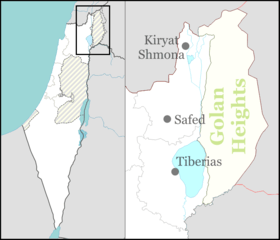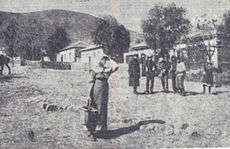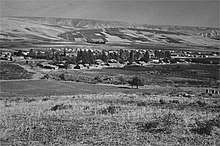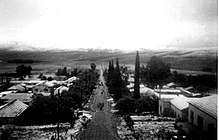Yavne'el
Yavne'el (Hebrew: יַבְנְאֵל, Arabic: يفنيئيل) is a moshava and local council in the Northern District of Israel. It is one of the oldest rural Jewish communities in the country.[2] According to the Israel Central Bureau of Statistics (CBS), in 2019 it had a population of 4,243. In 2008 the population had been of 3,100, with a growth rate of 1.4%.
Yavne'el
| |
|---|---|
| Hebrew transcription(s) | |
| • ISO 259 | Yabnˀel |
View of Yavne'el | |
 Yavne'el  Yavne'el | |
| Coordinates: 32°42′34″N 35°29′58″E | |
| Grid position | 197/234 PAL |
| Country | |
| District | Northern |
| Founded | 1901 |
| Government | |
| • Type | Local council (from 1951) |
| • Head of Municipality | Ronny Cohen |
| Area | |
| • Total | 31,680 dunams (31.68 km2 or 12.23 sq mi) |
| Population (2019)[1] | |
| • Total | 4,243 |
| • Density | 130/km2 (350/sq mi) |
History

Archaeological overview
Remains from the Late Bronze Age,[3][4] Iron Age I–II,[3] Persian,[3] Hellenistic,[5] Roman,[3], Late Byzantine,[3][4][6] Early Muslim[7] and Mamluk periods have been found here.
A residential building constructed in the Umayyad period that continued to be inhabited during the Abbasid period (eighth–tenth centuries CE) has been excavated here.[7]
Ottoman period
Arab village
During the Ottoman period the Muslim village in the area was known as ’’Yemma’’.[8] The village was mentioned in the Ottoman defter for the year 1555-6, located in the Nahiya of Tabariyya of the Liwa of Safad, with its land designated as Timar land.[9]
A map by Pierre Jacotin from Napoleon's invasion of 1799 noted the place.[10] In 1875 Victor Guérin visited, and described the village as rather ruined and built of basaltic stone, situated in a fertile valley.[11] In 1881, the PEF's Survey of Western Palestine (SWP) described Yemma as having basaltic stone houses, containing 100 Muslims, on an arable plain. There were no gardens or trees, but two springs were near, and the village had cisterns.[12] To the south-west of this site there was a supply of water among the rocks of the valley.[13]
Jewish settlement
The "Yamah" settlement was initially planned for 40 farms, each holding 300 dunams.[14] What is now Yavne'el was established on October 7th, 1901, by the Jewish Colonization Association on lands bought from the Delaike (Al-Dalaika) Bedouin tribe by Baron Rothschild.[15][16] The first settlers came from the Hauran region (Jewish settlers of the Hauran or "Horan" as it was called, had been evicted from there in 1898 by the Ottoman authorities),[16] joined in December 1901 by villagers from Metula.[14][15] In 1914–15, immigrant families from the Yemen settle in Yavne'el.[14]
The new colony of Beit Gan was founded in 1904[14] as a moshav.[17]
British Mandate
In the 1922 census of Palestine conducted by the British Mandate authorities, Yabnieh (Yamma) had a total population of 447; 82 Muslims and 365 Jews.[18] At the time of the 1931 census, Yavneel still had exactly the same population of 447; but now it was 56 Muslims and 391 Jews, in a total of 102 houses.[19]
Hitahdut HaMoshavot BeYehuda VeShomron ("Association of moshavot in Judea and Samaria"), the oldest settlement movement for private farmers in the Land of Israel, was founded in Yavne'el in 1920.
When three Jewish residents were murdered by Arab rioters on the road between Yavne'el and Beit Gan in 1937 during the country-wide Arab revolt, a new settlement named in their honour, the moshav Mishmar HaShlosha (lit. "Guard of the Three"), was established nearby.[14]

In the 1945 statistics, Yavneel was home to 590 people, all Jews.[20][21]
In 1947 an improvised landing strip in the fields of the moshava was used for landing by a transport airplane bringing Jewish refugees, twice from Baghdad and once from Italy.[22]
State of Israel

Located southwest of Tiberias, it was declared a local council in 1951.
Many organisations were established in Yavne'el, including the Israeli Farmers Union, the Galilee Squadron and the Golani Brigade.
Administration
The local council is jointly responsible for Yavne'el, Beit Gan, Mishmar HaShlosha, and Smadar.[17] The first three were established as moshavot (early Zionist agricultural colonies) and are very close to each other, while Smadar, originally a moshav (communal village with more economic autonomy for the member families than a kibbutz), is slightly farther away.[17]
Farmer community
In 1991, the authors of a book on Jewish identity in contemporary Israel noticed that, although in many ways typical for the processes Israeli society underwent since its inception, Yavne'el has a core group of farmers described as "rooted yeomanry", uncommon outside the few moshavot of the first hour of Zionist settlement that retained their initial rural character - no more than a dozen in the entire country.[23] These farmers are deeply connected to the place, dedicated to working the land, and see themselves as spearheading the tremendously important task of returning the nation to a set of values long lost or ignored by Jews everywhere else, starting with different-minded neighbours from Yavne'el.[23] They are compared to wheat farmers of the American Midwest or Sweden, in the way they both sound and look.[23]
Breslov community
In 1986, Rabbi Eliezer Shlomo Schick founded a Breslov community largely consisting of baalei teshuvah (newly religious) adherents in Yavne'el. As of 2015 this community, which calls itself "Breslov City"[24], numbers nearly 400 families, representing 30 percent of the town's population.[25] The community has its own educational and civic organizations, including a Talmud Torah, girls' school, yeshiva ketana, yeshiva gedola, kollel,[26] beis medrash (study/prayer hall), and charity and humanitarian organizations.[25]
Notable residents
- Ruth Amiran (1914–2005), Israeli archaeologist
- Keren Peles (born 1979), Israeli singer-songwriter and pianist
- Eliezer Shlomo Schick (1940–2015), Hasidic rabbi
See also
- Saham al-Jawlan, village in the Hauran with a short-lived Jewish settlement (1895-96), some of whose colonists, evicted by Ottoman authorities, became the founders of Yavne'el
References
- "Population in the Localities 2019" (XLS). Israel Central Bureau of Statistics. Retrieved 16 August 2020.
- Tradition, Innovation, Conflict: Jewishness and Judaism in Contemporary Israel, ed. Zvi Sobel and Benjamin Beit-Hallahmi
- Leibowitz 1995, cited in Hanna, 2017, Yavne’el
- Brink, van den, 2017, Yavne’el, Tel Yin’am
- Dalali-Amos, 2011, Yavne’el, Bet Gan
- Hanna, 2009, Yavne’el
- Hanna, 2017, Yavne’el
- from a personal name, according to Palmer, 1881, p. 138
- Rohde, 1979, p. 104
- Karmon, 1960, p. 167.
- Guérin, 1880, p. 268
- Conder and Kitchener, 1881, SWP I, p. 362
- Conder and Kitchener, 1881, SWP I, p. 379
- Leah Haber Gedalia (2018). "Yavne'el, Israel: The First Century (1901-2001). A Timeline" (PDF). JewishGen KehilaLinks. Retrieved 5 December 2019.
- Avik Kustizki, Yossi Dolah, Amit Ben Zvi - Heads of the Yavne’el, Kefar Tavor, and Menahamiya Local Councils, respectively (2001). "Centenary of Yavne'el , Kefar Tavor & Menahamiya". Israel Philatelic Federation. Retrieved 5 December 2019.CS1 maint: uses authors parameter (link)
- Ben-Porat, Amir (1991). "Immigration, proletarianization, and deproletarianization: A case study of the Jewish working class in Palestine, 1882-1914". Theory and Society (20): 244.
- Yavneel Local Council, Lower Galilee, Galilee Development Authority website, retrieved 6 December 2019
- Barron, 1923, Table XI, Sub-District of Tiberias, p. 39
- Mills, 1932, p. 85
- Department of Statistics, 1945, p. 12
- Government of Palestine, Department of Statistics. Village Statistics, April, 1945. Quoted in Hadawi, 1970, p. 73
- "Operation 'Michaelberg': a Commando transport flown by two American pilots brings illegal Jewish immigrants from Iraq into Palestine". Israeli Air Force. Retrieved 5 December 2019.
- Sobel, Zvi; Beit-Hallahmi, Benjamin (1991). Tradition, Innovation, Conflict: Jewishness and Judaism in Contemporary Israel. SUNY series in Israeli Studies. SUNY Press. ISBN 9780791405550. Retrieved 5 December 2019.
- "yavne'el in breslevcity".
- "Harav Eliezer Shlomo Shick, zt"l, of Yavne'el". Hamodia, Israel news, February 12, 2015, p. 9.
- Tzoren, Moshe Michael. "Away From the Hustle and Bustle of the Big City: Investors from Israel and abroad are buying up large lots in Yavniel, a quiet village in the Galilee, with an eye on building hundreds of housing units for the chareidi public". Hamodia Israel news, 23 December 2010, pp. A26-A27. Retrieved 29 January 2011.
Bibliography
- Barron, J. B., ed. (1923). Palestine: Report and General Abstracts of the Census of 1922. Government of Palestine.
- Brink, van den, Edwin C.M. (2017-12-04). "Yavne'el, Tel Yin'am" (129). Hadashot Arkheologiyot – Excavations and Surveys in Israel. Cite journal requires
|journal=(help) - Conder, C.R.; Kitchener, H.H. (1881). The Survey of Western Palestine: Memoirs of the Topography, Orography, Hydrography, and Archaeology. 1. London: Committee of the Palestine Exploration Fund.
- Dalali-Amos, Edna (2011-08-16). "Yavne'el" (123). Hadashot Arkheologiyot – Excavations and Surveys in Israel. Cite journal requires
|journal=(help) - Dalali-Amos, Edna (2011-12-19). "Yavne'el, Bet Gan" (123). Hadashot Arkheologiyot – Excavations and Surveys in Israel. Cite journal requires
|journal=(help) - Department of Statistics (1945). Village Statistics, April, 1945. Government of Palestine.
- Guérin, V. (1880). Description Géographique Historique et Archéologique de la Palestine (in French). 3: Galilee, pt. 1. Paris: L'Imprimerie Nationale.
- Hadawi, S. (1970). Village Statistics of 1945: A Classification of Land and Area ownership in Palestine. Palestine Liberation Organization Research Centre.
- Hanna, Butros (2009-09-30). "Yavne'el" (121). Hadashot Arkheologiyot – Excavations and Surveys in Israel. Cite journal requires
|journal=(help) - Hanna, Butros (2017-08-29). "Yavne'el" (129). Hadashot Arkheologiyot – Excavations and Surveys in Israel. Cite journal requires
|journal=(help) - Karmon, Y. (1960). "An Analysis of Jacotin's Map of Palestine" (PDF). Israel Exploration Journal. 10 (3, 4): 155–173, 244–253.
- Palmer, E.H. (1881). The Survey of Western Palestine: Arabic and English Name Lists Collected During the Survey by Lieutenants Conder and Kitchener, R. E. Transliterated and Explained by E.H. Palmer. Committee of the Palestine Exploration Fund.
- Rhode, H. (1979). Administration and Population of the Sancak of Safed in the Sixteenth Century. Columbia University.
External links
- Nefesh B'Nefesh Community Guide for Yavnael, Israel
- Official website of Breslov community in yavne'el
- Survey of Western Palestine, Map 6: IAA, Wikimedia commons
